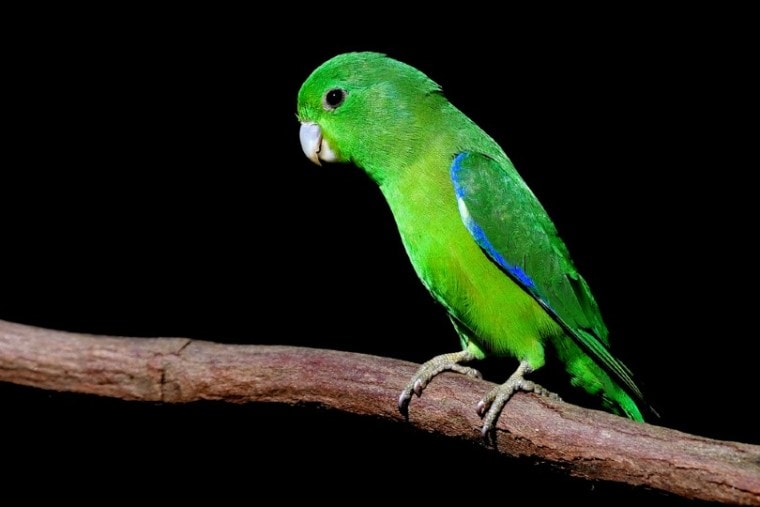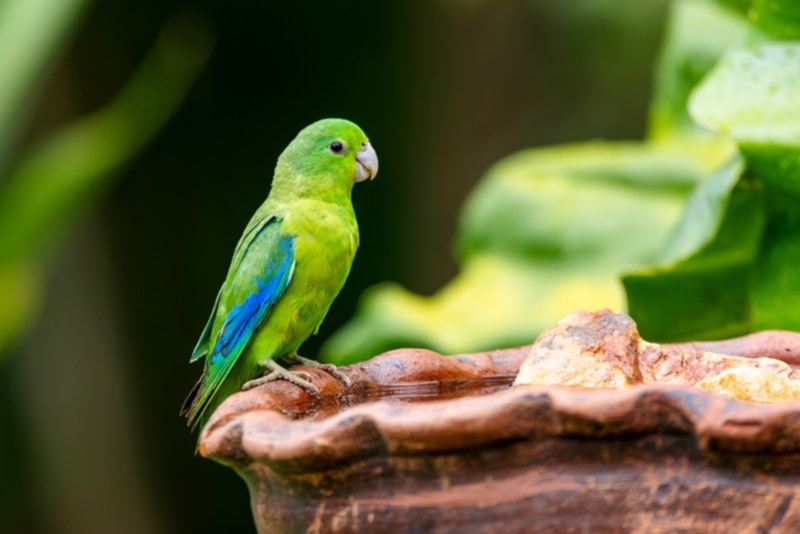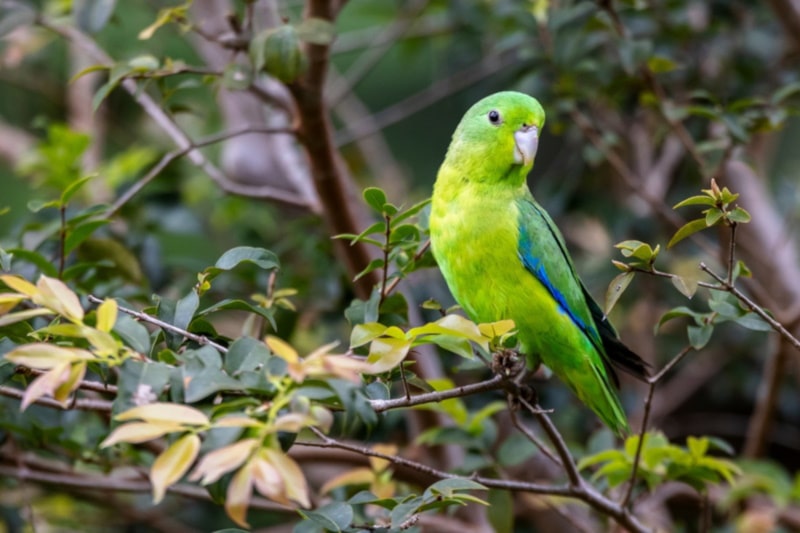
The tiny, adorable, and spunky Blue-Winged Parrotlet is small in size but huge in personality. These little birds are easy to care for, affectionate, and full of energy and have become a popular pet for small bird enthusiasts. These birds are highly social and form strong bonds with their owners. With an average lifespan of 20 years or more, they’ll be your close companion for years to come.
Parrotlets are the smallest birds in the parrot family — even smaller than Budgies — giving them the nickname, “pocket parrots.” They may be small, but they are certainly not short on energy and have all the personality and character of their larger cousins.
If you’d like to know more about these pint-sized parrots, read on for an in-depth guide on their history, personality, and care.
Species Overview
| Common Names: | Salvadori’s Blue-Winged Parrotlet, Hellmayr’s Blue-Winged Parrotlet |
| Scientific Name: | Forpus xanthopterygius |
| Adult Size: | 4-5 inches |
| Life Expectancy: | 15-20 years |
Origin and History
The Blue-Winged Parrotlet is found throughout central and northern South America, with the highest population in the Amazon Basin. They can be found in dry woodlands, savannas, scrublands, and palm groves, but they can often be seen frequenting neighborhoods too. They tend to avoid densely wooded areas and prefer to stick to lowlands and are rarely found at altitudes of over 3,900 feet.
These parrots were one of the first parrot species that were taken to Europe from South America around the early 1500s, and their popularity as pets has grown ever since. The exact population of Blue-Winged Parrotlets in the wild is not known, but it is stable. Even the thriving pet trade has not threatened their numbers, with a large part of their habitat already protected.

Temperament
The Blue-Winged Parrotlet has an affectionate, loving, and outgoing personality, and these birds become strongly attached to their owners. They are playful animals that can be mischievous at times, though all in the name of fun. They love being held and even cuddled, so they are great companions for hands-on owners. In fact, they need a great deal of interaction and attention to prevent them from becoming bored. Otherwise, they can get rather destructive. These little birds are certainly not content to sit alone in a cage all day long. They need plenty of time outside of their habitat playing with toys and interacting with their owner. If you are away from home frequently, this is certainly not an ideal choice of pet.
Speech & Vocalizations
The Blue-Winged parrot is ideal for apartment living because they are a relatively quiet species. They will, like all parrots, make screeching, piercing natural calls occasionally but at a relatively low volume. Also, these birds are not known for talking. While some may be able to mimic a few words, they will, for the most part, stick to natural sounds and rarely learn more than a handful of words.

Blue-Winged Parrotlet Colors and Markings
As the name suggests, the Blue-Winged Parrotlet is most recognizable by the striking blue patches on their wings, although this is limited to males only. They have bright olive green bodies, long green tails, and a small pale grey bill. Their eyes are surrounded by bright green feathering, and they typically have dark brown eyes. Instead of the bright blue/purple markings, females have green and yellow faces and wings.
Caring for the Blue-Winged Parrotlet
One of the biggest draws of keeping these parrots as pets is their ease of care. Since they are so small, they are far easier to house and feed. These birds are highly social animals in their natural habitat, often forming flocks of up to 50 birds, so it makes sense that they would enjoy having a partner of their own species to keep them company. They tend to feed in groups of two or more in the wild too, so they’ll certainly appreciate another bird of the same species to live with.
That said, this is not essential because they bond strongly with their human companions too. If you have the time to interact and play with your parrot, they’ll get the companionship that they need. They become bored and lonely quickly, though, so they need almost constant interaction if they don’t have a partner.
Since these birds are so small, you should avoid large baths and opt for a gentle spray of water instead to keep them clean.
Common Health Problems
These parrots may be small, but they are certainly not fragile and are known for their hardiness and adaptability. The most common cause of ill health in parrots is poor diet, but stress, loneliness, and bad living conditions play huge parts too. With the right diet, housing, and plenty of stimulation and interaction, though, these birds can easily live for 20 years and beyond!
It’s important to note that these birds are experts at hiding illness, as in the wild, they are less likely to be preyed upon. Taking your Parrotlet for a checkup with an avian vet once every 6-12 months is highly recommended.
Diet and Nutrition
The Parrotlet’s natural diet consists mostly of seeds, small insects, and fruits. The best way to mimic this in captivity is with high-quality commercial pellets, as this will provide them with all the nutrition that they need. You can add in fresh fruits and vegetables for minerals and vitamins, although not too much, as well as seed mix occasionally too. They’ll also benefit from an additional source of calcium, such as cuttlebone, although commercial pellets should provide all they need. Seed mixes should only make up around 25% of their diet. While your parrot may love them, they do not have the required nutrition. Pellets should make up 50-75% of their diet, with the rest being fresh fruit and vegetables.

Exercise
Despite their size, these little birds are active and love climbing. Their cage should be outfitted with perches, ladders, ropes, and plenty of toys to provide them with both the mental and physical stimulation that they need. That said, time outside of their cage is also essential because it will help with socialization and help keep them stimulated. Luckily, these birds love to play and adore interaction with their owners, so exercise is usually not a problem.
Where to Adopt or Buy a Blue-Winged Parrotlet
If you’ve decided that the Blue-Winged Parrotlet is the bird for you, you may be wondering where to buy one. While these birds can readily be found in pet stores throughout the United States, we recommend adopting or buying from a breeder. There are plenty of people who have purchased one of these birds without realizing the responsibility that they entail and have given them up for adoption. When you adopt a Parrotlet, you’ll not only be saving money but also giving a loving home to a bird in need.
If you decide to purchase a young bird, look for a reputable breeder, as this will usually ensure good genetics and thus, better health of your Parrotlet overall. Try to avoid buying birds from pet stores because these are typically not as healthy or happy as birds from dedicated breeders. Depending on the breeder and availability, you can expect to pay $200-$400 for a Blue-Winged Parrotlet.
Final Thoughts
The Blue-Winged Parrotlet is a small bird with a huge personality packed into their tiny body. They are easy-to-care-for, outgoing, and affectionate animals that make great birds for beginners. They are ideal for apartments because they are not loud or noisy birds, but they are not great at mimicking speech either. With a lifespan of around 20 years, this bird will be with you for many years to come and is certainly a huge responsibility not to be entered into lightly. That said, Blue-Winged Parrotlets are wonderful companions that will give you years of joy.
Featured Image Credit: KAROLINEZAMLUTI, Shutterstock











